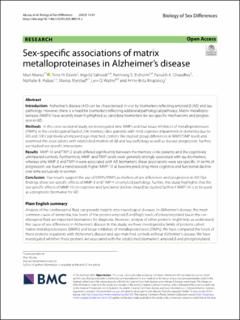| dc.contributor.author | Aksnes, Mari | |
| dc.contributor.author | Edwin, Trine Holt | |
| dc.contributor.author | Saltvedt, Ingvild Tina | |
| dc.contributor.author | Eldholm, Rannveig Sakshaug | |
| dc.contributor.author | Chaudhry, Farrukh Abbas | |
| dc.contributor.author | Halaas, Nathalie Bodd | |
| dc.contributor.author | Myrstad, Marius | |
| dc.contributor.author | Watne, Leiv | |
| dc.contributor.author | Knapskog, Anne Brita | |
| dc.date.accessioned | 2023-07-18T14:54:49Z | |
| dc.date.available | 2023-07-18T14:54:49Z | |
| dc.date.created | 2023-06-14T18:25:36Z | |
| dc.date.issued | 2023 | |
| dc.identifier.citation | Biology of Sex Differences. 2023, 14 (1), . | en_US |
| dc.identifier.issn | 2042-6410 | |
| dc.identifier.uri | https://hdl.handle.net/11250/3079735 | |
| dc.description.abstract | Introduction
Alzheimer’s disease (AD) can be characterised in vivo by biomarkers reflecting amyloid-β (Aβ) and tau pathology. However, there is a need for biomarkers reflecting additional pathological pathways. Matrix metalloproteinases (MMPs) have recently been highlighted as candidate biomarkers for sex-specific mechanisms and progression in AD.
Methods
In this cross-sectional study, we investigated nine MMPs and four tissue inhibitors of metalloproteinases (TIMPs) in the cerebrospinal fluid of 256 memory clinic patients with mild cognitive impairment or dementia due to AD and 100 cognitively unimpaired age-matched controls. We studied group differences in MMP/TIMP levels and examined the associations with established markers of Aβ and tau pathology as well as disease progression. Further, we studied sex-specific interactions.
Results
MMP-10 and TIMP-2 levels differed significantly between the memory clinic patients and the cognitively unimpaired controls. Furthermore, MMP- and TIMP-levels were generally strongly associated with tau biomarkers, whereas only MMP-3 and TIMP-4 were associated with Aβ biomarkers; these associations were sex-specific. In terms of progression, we found a trend towards higher MMP-10 at baseline predicting more cognitive and functional decline over time exclusively in women.
Conclusion
Our results support the use of MMPs/TIMPs as markers of sex differences and progression in AD. Our findings show sex-specific effects of MMP-3 and TIMP-4 on amyloid pathology. Further, this study highlights that the sex-specific effects of MMP-10 on cognitive and functional decline should be studied further if MMP-10 is to be used as a prognostic biomarker for AD. | en_US |
| dc.language.iso | eng | en_US |
| dc.publisher | BMC | en_US |
| dc.rights | Navngivelse 4.0 Internasjonal | * |
| dc.rights.uri | http://creativecommons.org/licenses/by/4.0/deed.no | * |
| dc.title | Sex-specific associations of matrix metalloproteinases in Alzheimer’s disease | en_US |
| dc.title.alternative | Sex-specific associations of matrix metalloproteinases in Alzheimer’s disease | en_US |
| dc.type | Peer reviewed | en_US |
| dc.type | Journal article | en_US |
| dc.description.version | publishedVersion | en_US |
| dc.source.pagenumber | 0 | en_US |
| dc.source.volume | 14 | en_US |
| dc.source.journal | Biology of Sex Differences | en_US |
| dc.source.issue | 1 | en_US |
| dc.identifier.doi | 10.1186/s13293-023-00514-x | |
| dc.identifier.cristin | 2154646 | |
| cristin.ispublished | true | |
| cristin.fulltext | original | |
| cristin.qualitycode | 1 | |

